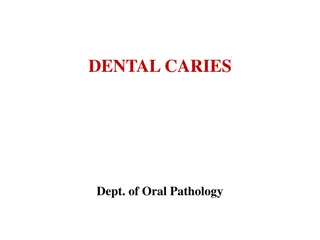Understanding Enamel Pearl Anomaly in Dentistry
Enamel Pearl is a developmental anomaly where small nodules of enamel form below the cemento enamel junction, mainly on permanent teeth. This anomaly, detected radiographically, can lead to bacterial accumulation, periodontal issues, and inflammation if left untreated. Dental hygienists play a crucial role in early diagnosis to prevent periodontal pocket development, and treatment involves removal or intervention for proper biofilm control.
Download Presentation

Please find below an Image/Link to download the presentation.
The content on the website is provided AS IS for your information and personal use only. It may not be sold, licensed, or shared on other websites without obtaining consent from the author. Download presentation by click this link. If you encounter any issues during the download, it is possible that the publisher has removed the file from their server.
E N D
Presentation Transcript
Enamel Pearl Wendy Rodriguez DEN 1114-D218
What is Enamel Pearl ? Enamel Pearl is a developmental anomaly in which there is a small nodule of enamel below the cemento enamel junction. Enamel pearls occur mainly on permanent teeth, but primary teeth can also be affected. Enamel pearls appear as small, well-defined globules of enamel, generally round, white, smooth and glass-like, that adhere to the root surface. The diameter can vary in size between 0.3 and 4 mm.
Etiology The enamel pearl is considered an abnormality. It is a developmental, localized formation of enamel occurring on the root surface. It is an area where stellate reticulum (the middle layer of the enamel organ) is retained between the two layers of epithelium that normally comprise the root sheath. The presence of the stellate reticulum allows differentiation of the root sheath cells into ameloblasts, leading to the formation of a small area of enamel on the external root surface. Enamel pearls form when cells of the epithelial root sheath do not migrate away from the dentin. They may also be referred to as enamel droplet, enamel nodule, enamel globule, enamel knot, enamel exostose, enameloma, and adamantoma.
Radiographically Radiographically, the enamel pearl is observed as a smooth, radiopaque structure on the root of a multirooted tooth.
Negative Effects Enamel Pearl can cause bacterial accumulation around the structure and can result in tissue destruction, development of periodontal pockets, and inflammation. Enamel pearl can enhance plaque retention. This may predispose a particular site to periodontal problems.
Role of a Dental Hygienist Early diagnosis of the enamel pearl is very important to prevent development of periodontal pockets. Radiographs must be carefully analyzed because sometimes Enamel Pearl may be confused with calculus. Unidentified Enamel Pearl can possibly initiate or aggravate periodontal diseases. Ideally, if radiographs are taken before any scaling procedure is performed, the dental hygienist can detect the enamel pearl. This will eliminate the potential for a broken instrument tip. The structure is solid and my be mistaken for calculus. Repeated attempts to dislodge the enamel pearl may result in a broken instrument tip.
Treatment Enamel Pearl must be removed or undergo intervention to allow access to the area for proper biofilm control by patients and professionals in order to prevent future attachment loss.
Case Report A 30-year-old man systemically healthy presented with chief complaint of bleeding gums. Periapical radiograph revealed severe bone loss around the mandibular first molar. The presence of one enamel pearl on the first right molar on mesial root surface (Figure 1). Periodontal probing showed local bleeding on interproximal areas. A diagnosis of chronic localized severe periodontitis was established. Non-surgical periodontal therapy (scaling and root planning) was done. After one month periodontal regenerative surgical therapy with odontoplasty was planned (Figure 2). Reevaluation and follow up planned. Figure 1 Figure 2























